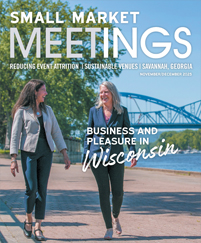It’s a nightmare most every event planner has had: The day of the big conference arrives. The doors open. No one walks in.
Thankfully, the dream never becomes reality. Still, turnout sometimes disappoints, and a planner is left to figure out why attendance was off and how to keep it from happening again.
There’s a lot that goes into drawing a crowd. Here are five areas to think about as you plan your next conference.
Is the price right?
Depending on travel budgets, the cost of a conference might be a sticking point. That’s why it’s essential to adopt some retailing strategies like offering early bird discounts, group discounts for businesses and other deals. Getting attendees to sign up early or en masse will give your conference a healthy start and a good foundation. Offering the option to attend virtually is also something to consider. There are always people who lack either the time or money to attend in person but who would still like to take in the conference’s educational sessions and keynote speakers.
Another way to raise awareness of your conference and demonstrate its value to someone who can’t attend is to offer, for a fee, downloads of educational sessions. Hearing the speakers your conference books might just convince someone to attend the conference in person the next year.
Does the destination draw a crowd?
Where a conference is held can make a difference in attendance. Do you know what excites your audience? Is it a city with appealing features, like a convention center with an attached hotel in a walkable, safe downtown like you’ll find in Fort Wayne, Indiana? Will the destination interest particular professionals? For example, if it’s a conference for those in the hotel industry, wouldn’t Ithaca, New York, home to Cornell University and its high-profile hotel management program, be a good choice? If attendees are flying, will they be able to get reasonable airfare and good flight options? One way to ensure that would be to meet in the Chicago suburbs, close to O’Hare and Midway airports. Those areas are represented by several CVBs, including Visit Chicago Southland, Chicago’s North Shore, Visit Lake County and Meet Chicago Northwest.
If the conference always meets in the same city, it might be time to try something new. Most CVBs will host a meeting planner who wants to check out a destination in person. These familiarization trips can be the first step in building a relationship with a CVB.
How much marketing is enough?
Remember this old marketing mantra? A customer must see an ad for a product seven times before they’ll buy it. That was in the days when newspapers and television dominated advertising. These days, it might take a lot more than seven, as we’re all inundated with marketing messages from the smartphones in our hands and the laptops on our desks. Conference marketing requires a multifaceted approach. Email marketing, social media marketing and content marketing all come into play through online newsletters, blogs, text reminders and updates, a conference website, videos and stories on social media, a conference hashtag and more.
The goal should be to reach out in as many ways and as many times as possible with varied content to capture your target audience’s interest. A CVB partner can also help market a conference by supplying photography of the city, videos, online visitors guides and other marketing materials. The Greater Palm Springs CVB, for example, can create microsites for events held there.
What do they want to learn?
Many people will want to see the lineup of speakers and sessions before they commit to attending, so push out that information early. They also want to come away with new insights and information, so make sure the conference’s speakers and sessions are pertinent to the problems and challenges attendees face. To find the best speakers, do some crowdsourcing. If you’re a member of MPI, ASAE or other meeting industry associations, reach out to fellow members for ideas. Research who is speaking to organizations that are similar to yours. Ask members of your board or executive committee if they have suggestions based on speakers they have heard at conferences they attend. If the conference format is creative in the way information will be delivered — perhaps through hands-on activities, behind-the-scenes tours, interactive sessions, lively panels or spirited roundtables — promote that in your marketing.
Who can spread the word?
Chances are you know several people who are unofficial “influencers” — key figures in your organization whom others respect and listen to. What if you found a way to turn them into recruiters for your conference? Perhaps you could do a short video and have them talk about why they attend the conference and what specifically they have gained by attending. No need for fancy cameras; your smartphone will work just fine for short videos and photos. These ambassadors could also send personal messages — emails, texts, personal notes — to people they know who might not be registered yet, encouraging them to do so.
Longtime suppliers, who either participate in your tradeshow or simply attend the conference to network, might reach out to customers who could benefit from attending and encourage them to sign up. Reward registrants who convince a peer to sign up for the conference with an Amazon gift card. These rate second only to cash in terms of preferred incentives, experts say.










